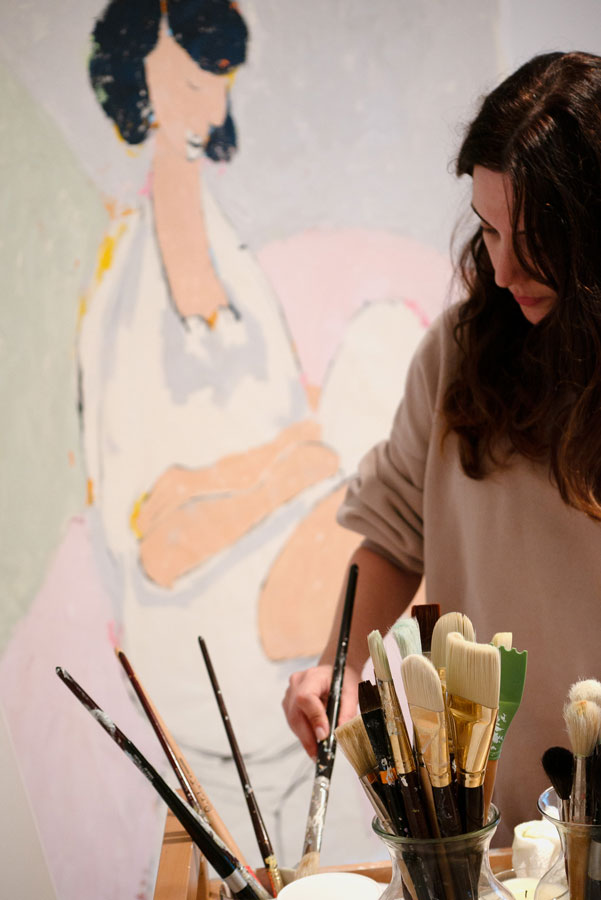
Interview with ZuZi
Interview 7/30/24
1.As a former street photographer, when and how did you transition to paint? What in this medium attracts you specifically?
As a former street photographer, my transition to painting was a gradual process rather than a sudden shift. I’ve always loved telling stories through visuals. While photography allowed me to capture the world around me, painting gave me the opportunity to dive deeper into personal expression. One of the things that drew me to painting was the actual hands-on aspect—mixing colors, applying paint to the canvas, and creating textures. It felt like a new kind of freedom, where I could share emotions and ideas in a really fun and creative way. Painting lets me explore things beyond what we see in reality, making it a special and fulfilling way to express myself.
2.Is there a link between your artistic work today and your previous photographic work?
Yes, definitely. There's a strong connection between my current work and my previous photographic work, as both come from my perspective. Even though I've moved from using a camera to using paint, the essence of my creative expression remains the same. Both mediums allow me to explore and share my viewpoint, capturing moments, emotions, and stories. My experience in photography has shaped how I see composition and light, and that still influences my painting style. In the end, both forms of art reflect how I see and understand the world around me.
3.Do you want to explore other media or techniques at some point?
Of course, I’m always open to exploring other media and techniques. Every new medium offers a unique way to express creativity and discover new aspects of artistic expression. Experimenting with different materials and methods can bring fresh perspectives and ideas, helping me grow as an artist. Whether it’s sculpture, digital art, or mixed media, I’m excited about the possibilities and eager to continue evolving my artistic practice.
4.What is your creative process? What are the different steps from concept to finished artwork?
My creative process usually starts with an idea or inspiration, which can come from anything—emotions, experiences, nature, a fleeting moment, a conversation, or even a particular color or texture that catches my eye. I start by sketching out rough concepts, letting my thoughts and emotions flow onto canvas. These sketches help me visualize how I want to bring the idea to life. Once I have a rough sketch, I gradually build up the details, adjusting and refining as I go. I’m always open to changes and new ideas that may arise during the process. Finally, I add the finishing touches and ensuring everything looks harmonious and feels complete.
5.What - or who - inspires you ?
I’m inspired by many things, like nature, emotions, and personal experiences. The beauty of the natural world often sparks my creativity, as do the complexities of human emotions and interactions. Additionally, other artists, both contemporary and historical, also influence and motivate me with their unique styles and perspectives. Personal experiences and the stories of those around me play a significant role in shaping my work. All these inspirations come together to fuel my artistic expression and exploration.
6.What is, in your opinion, the role of an artist in 2024?
I believe that artists shouldn’t be confined to any specific role. I prefer to be seen as a friend or family member who shares their perspective on life through their work. It’s about expressing my view of the world and inviting others to see it through my eyes. Rather than fitting into a particular role or expectation, I see my art as a way to connect and share my unique perspective.
7.Who are the characters in your paintings inspired from: yourself, people close to you, or imaginary?
The characters in my paintings are often a blend of different influences. They draw inspiration from myself, people close to me, and sometimes purely imaginary figures. Many times, the characters reflect my own emotions and experiences, subtly infused with parts of my personality. Other times, they’re inspired by people I know, capturing their essence or a special moment we’ve shared. I also enjoy creating imaginary characters, letting my creativity run free to embody abstract ideas or emotions. This mixallows me to tell diverse and nuanced stories, making each painting a unique exploration of human nature and imagination.
8.The characters in your paintings are almost always staring at the viewer or depicted in a contemplating posture. Is this an invitation for us to reflect or to join them into their relaxation?
When the characters in my paintings look directly at the viewer or appear deep in thought, it’s my way of inviting you to either reflect or relax with them. If they’re staring at you, it’s like they’re asking you to think about what they’re feeling or experiencing. When they’re in a calm, thoughtful pose, it’s an invitation to join them in a moment of peace and quiet. It’s all about creating a space where you can connect with the artwork in your own personal way.
9.Your titles are always interesting and thought-provoking. Do you have fun with them?
How do you come up with them? Yes, I definitely have fun coming up with titles for my pieces. I see them as an extension of the artwork, adding another layer of meaninrg. The process is quite intuitive; sometimes, the title comes to me even before I start the painting, while other times, it emerges as the piece develops. It’s a playful and creative part of the process that I really enjoy.